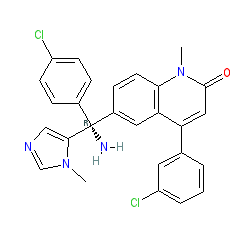GtoPdb is requesting financial support from commercial users. Please see our sustainability page for more information.
|
Synonyms: R-115777 | R115777
Compound class:
Synthetic organic
Comment: Tipifarnib is a non-peptidomimetic competitive farnesyltransferase inhibitor (FTI) [4].
Ligand Activity Visualisation ChartsThese are box plot that provide a unique visualisation, summarising all the activity data for a ligand taken from ChEMBL and GtoPdb across multiple targets and species. Click on a plot to see the median, interquartile range, low and high data points. A value of zero indicates that no data are available. A separate chart is created for each target, and where possible the algorithm tries to merge ChEMBL and GtoPdb targets by matching them on name and UniProt accession, for each available species. However, please note that inconsistency in naming of targets may lead to data for the same target being reported across multiple charts. ✖ |
|
|||||||||||||||||||||||||||||||||||
| No information available. |
Summary of Clinical Use  |
| Tipifarnib has been assessed in Phase 2I clinical trials for acute myeloid leukemia (AML) and advanced pancreatic cancer. Phase 2 trials for breast cancer, glioblastoma, malignant melanoma and non-small cell lung cancer are ongoing. Click here to link to ClinicalTrials.gov's listing of all tipifarnib trials. |
Mechanism Of Action and Pharmacodynamic Effects  |
| Tipifarnib inhibits the prenylation and therefore the membrane tethering capacity of RAS proteins, which are often hyper-activated in cancer. Loss of membrane anchorage leaves the RAS protein free in the cytosol where it is degraded. By reducing activity of RAS oncogenes tipifarnib inhibits cell growth, induces apoptosis, and inhibits angiogenesis [3]. However, the promise of FTIs has not been bourne out in clinical trials [2], perhaps due to redundancy in the system which sees geranylgeranyltransferase taking over the prenylation process, when farnesyltransferase is inhibited. |






